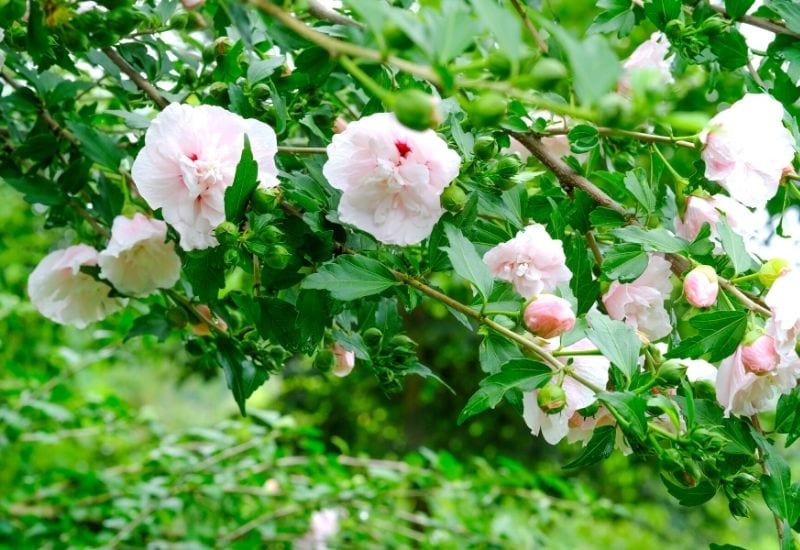
Rose of Sharon or Hibiscus syriacus is a flowering deciduous shrub shrub or small tree from Asia with showy, exotic flowers and you can train it to become a small tree.
It has the “Hawaiian” look of other hibiscus species, but it is very adaptable, fairly hardy and low maintenance.
For this reason, rose of Sharon has become a favorite variety of this genus among gardeners in temperate regions, like the USA and even Canada. It was introduced to Syrian gardens early on and then worldwide and now rose of Sharon has many varieties.
Rose of Sharon or hardy hibiscus is a member of the mallow family native of China and endemic of much of Asia. It has many cultivars developed by gardeners and the main differences are the flower color and size, plant size, and some have double and some semi double heads too.
Rose of Sharon flower comes in a host of shades including blue, red, lavender, purple, violet, white and pink, and open blossoms from summer to fall when many shrubs suffer from heat stress.
Which among the many varieties of rose of Sharon hibiscus is best for you? Let’s go through some of the most beautiful cultivars of Hibiscus syriacus shrubs together, and see which has the right plant size but also flower color, size and shape that you are looking for.
Rose of Sharon in Your Garden
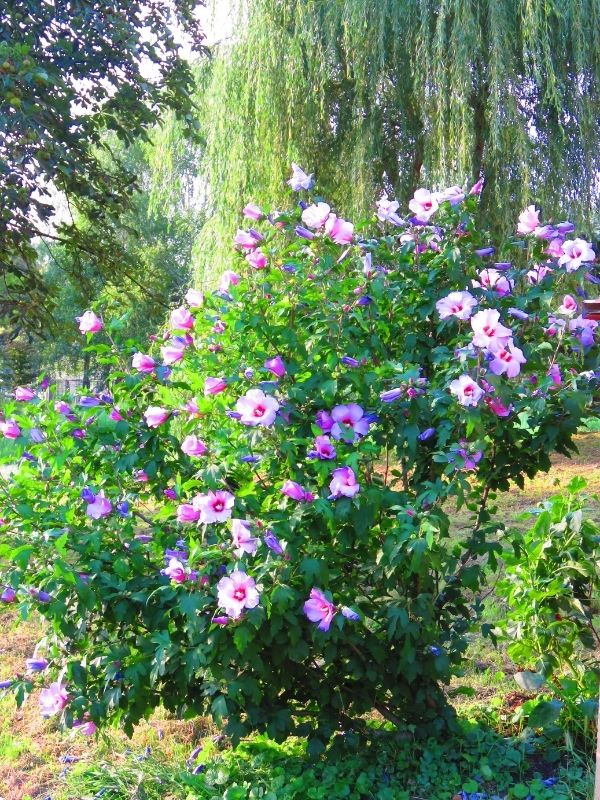
The main advantage of rose of Sharon is that it gives you showy flowers and lush foliage even if you don’t have much time for gardening. This hardy perennial will adapt to most types of soil, but make sure it is well drained and feed it every now and then.
It will naturally develop into a shrub, but it’s easy to prune it into a tree. In this case, the habit will be upright and the crown will have a spherical habit.
Rose of Sharon will usually bloom in summer, from July to August, but this may depend on the climate.
Rose of Sharon can be used for specimen planting and containers as a tree, and tall borders, hedges and screens as a shrub.
Now you are going to meet the best and most popular varieties of Hibiscus syriacus, all with different colors, some with unusual flowers and all beautiful. Choose wisely then!
14 Beautiful Rose of Sharon Varieties For Late-Summer And Fall Color
Here are 14 best rose of Sharon varieties with for continuous bursts of color to your garden from late summer to first frost.
1: Rose of Sharon ‘Purple Heart’ (Hibiscus syriacus ‘Purple Heart’)
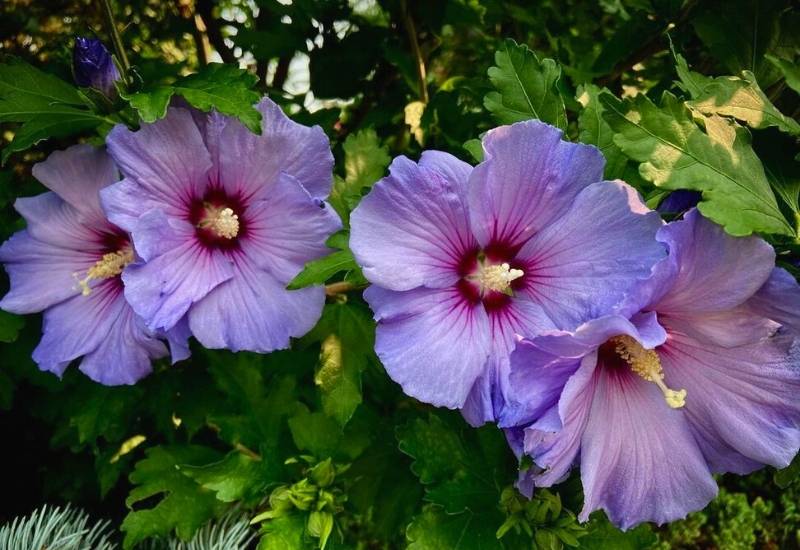
‘Purple Heart’ is a classic variety of rose of Sharon, you may have seen it in gardens already. It is super popular thanks to the striking color contrast it has in its petals.
These are white and well shaped, with a tip at the end. But the center is of a rich purple shade, so the flowers appear very showy. They can be 4 inches across, or 10 cm, so you can’t miss them.
Play with the color combination of rose of Sharon ‘Purple Heart’, maybe planting it next to flowers that pick up its amazing shades.
2: Rose of Sharon ‘Red Heart’ (Hibiscus syriacus ‘Red Heart’)
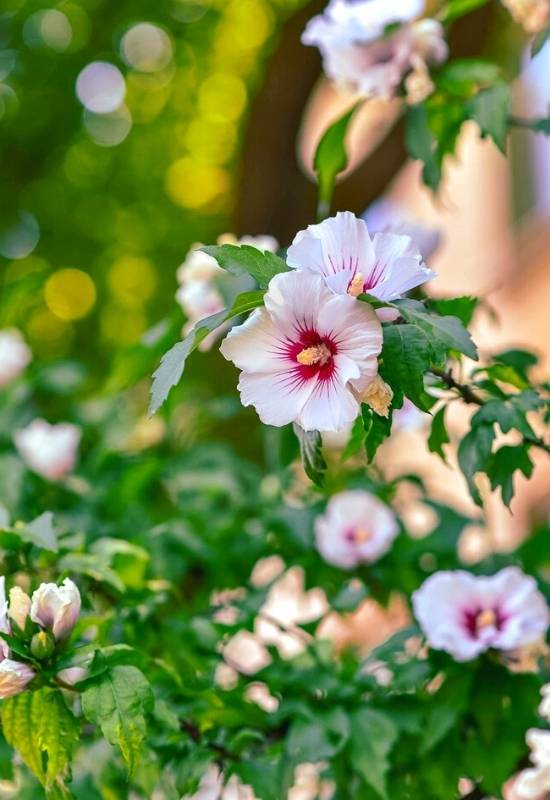
Rose of Sharon ‘Red Heart’ is a companion of the classic ‘Purple Heart’ but it is less famous. The name says it all: the petals are white with a red core… Actually they the color changes a bit, and it often tends to a deep magenta.
But this cultivar is a bit different form other varieties. Why? The single blooms only last one day but… the flip side is that ‘Red Heart’ flowers from July to fall, much longer than most other types of Hibiscus syriacus.
Choose ‘Red Heart if you want a strong color contrast and if you also need long lasting blooms.
3: Rose of Sharon ‘Oisaeu Bleau’
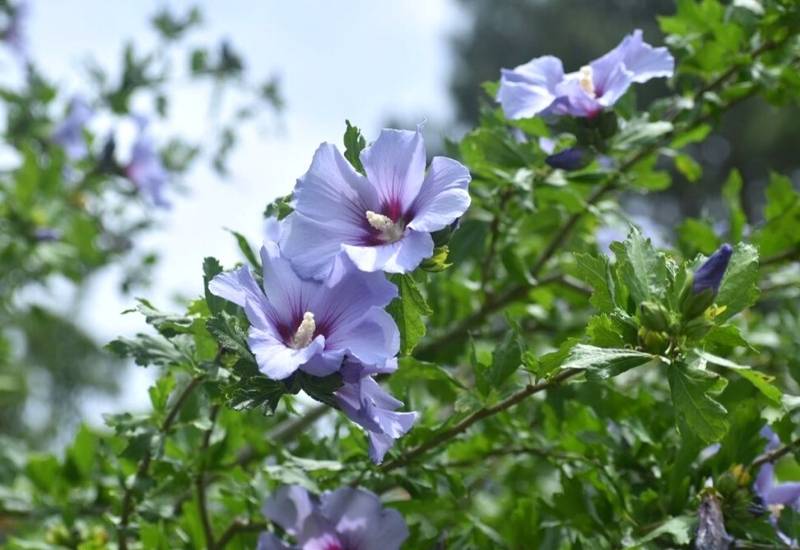
‘Oiseau Bleau’ is a very elegant variety of rose of Sharon, with harmonic coloring. The petals are mauve in color with a bright purple base at the center which ends in stripes, a bit like rays.
It is a very soothing but at the same time energetic combination. The flower heads are about 3 inches across (8 cm).
Hibiscus syriacus ‘Oiseau Bleau’ is ideal to bring peace to a garden; grow it in your hedge and it will calm down the whole design…
4: Rose of Sharon ‘Pink’ (Hibiscus syriacus ‘Pink’)
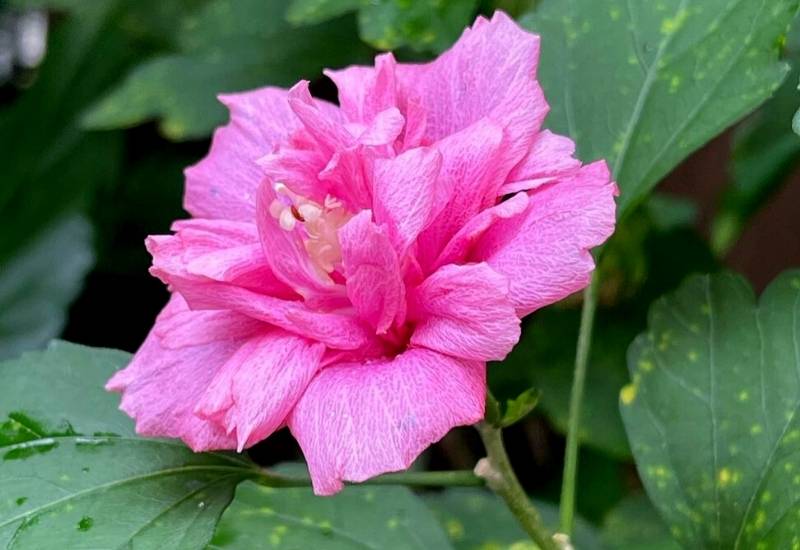
You can guess that the flowers of rose of Sharon ‘Pink’ are obviously, well, pink, in fact! The shade is delicate, pastel but full, which is quite difficult to achieve with this color in flowers.
They are of a fairly large size, and they can reach 4 inches across (10 cm). But this cultivar also has another peculiarly… The leaves are fuzzy, with a soft dawn on them.
Of course, my suggestion is to choose Hibiscus syriacus ‘Pink’ for a romantic effect. However, this shade is easy to mix and match with other colors, especially whites, reds and purples.
5: Rose of Sharon ‘Pink Chiffon’ (Hibiscus syriacus ‘Pink Chiffon’)
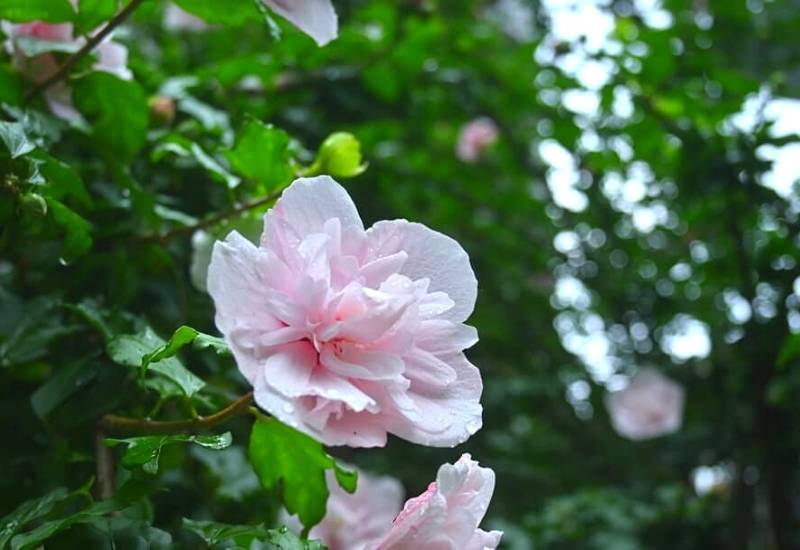
‘Pink Chiffon’ is the most romantic of all roses of Sharon! The color is of a pastel pink shade that makes you fall in love immediately. Add the fact that the petals are rounded but very delicate, with thin grooves, a bit like paper.
Finally, it is a semi double variety with small ruffled petals at the center that look like paper strips. The pistil is quite short for a hibiscus and it’s white.
You guessed; ‘Pink Chiffon’ would be my very first choice if you want to inject a but of summer romance into your garden.
6: Rose of Sharon ‘Marina’ (Hibiscus syriacus ‘Marina)
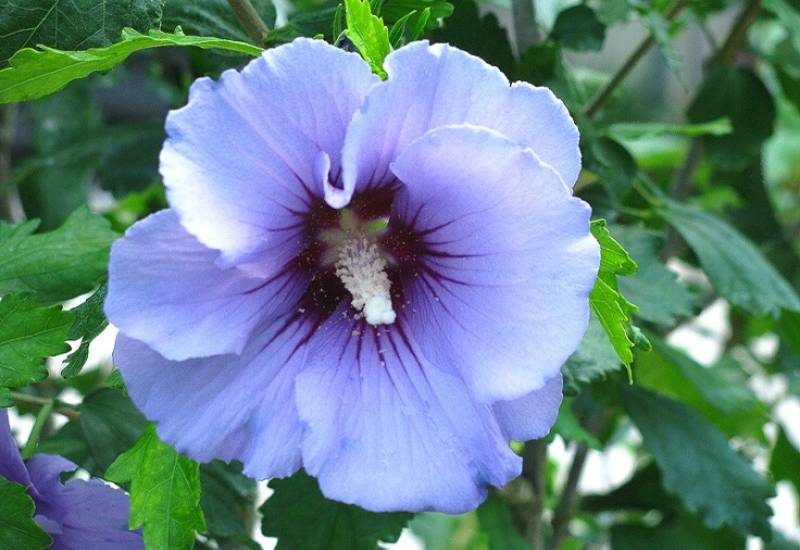
‘Marina’ is a cultivar with a unique appearance and color also called ‘Blue Stain’ in come nurseries. It has a small purple center with thin rays that leaf into the royal blue petals.
These are elegant and well proportioned and the light yellow pistils along the stamen draw the attention to the center of this very beautiful flower!
The color is a winner, of course, but let me give you a few more reasons to choose Hibiscus syriacus ‘Marina’… It is fairly drought resistant and it even tolerates salty soils. Finally, it is easy to propagate by stem cuttings!
7: Rose of Sharon ‘Lucy’ (Hibiscus syriacus ‘Lucy’)
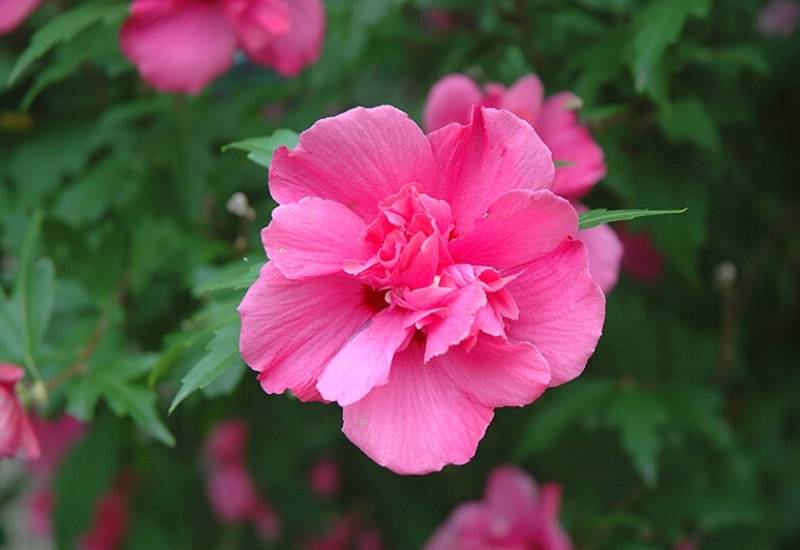
‘Lucy’ is a rose of Sharon with a strong and showy personality. The color is bright and deep magenta shade that none of your friends and visitors can miss.
Add the fact that ‘Lucy’ has fully double flowers and you get the full picture… they look a bit like real roses from a distance, and even if you look at the blooms at close range.
If you can’t afford labor intensive roses, Hibiscus syriacus ‘Lucy’ is a perfect replacement indeed. Alternatively, you can grow it for a showy and bright effect in your garden.
8: Rose of Sharon ‘Bluebird’ (Hibiscus syriacus ‘Bluebird’)
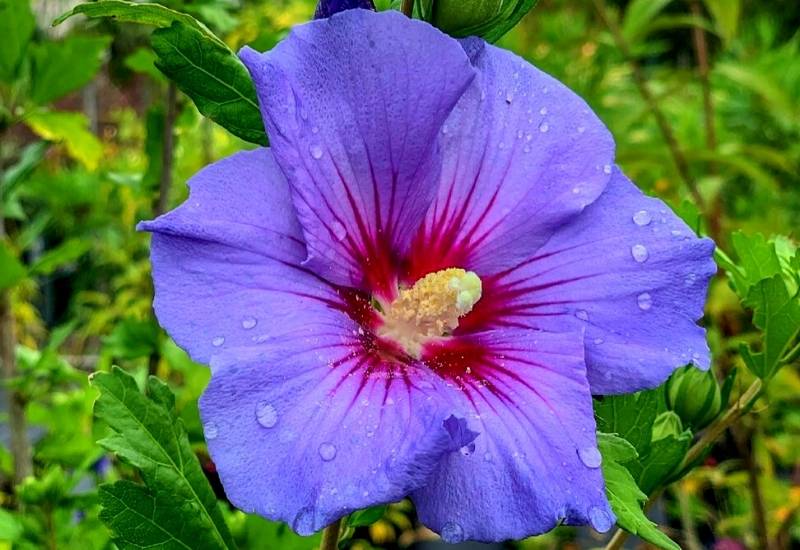
‘Bluebird’ is one of the most vibrant roses of Sharon ever! The petals have a deep and bright violet blue shade with purple centers. The overall effect is almost electric! The central pistil with stamens is white, which sets of the bright colors very clearly.
The flower heads are about 3 inches across (8 cm) and they look great against the rich emerald green color of the foliage.
Gardens often lack blue flowers in the summer months; if this is the color you are after, rose of ‘Sharon Bluebird’ is an excellent choice.
9: Rose of Sharon ‘Diana’ (Hibiscus syriacus ‘Diana’)
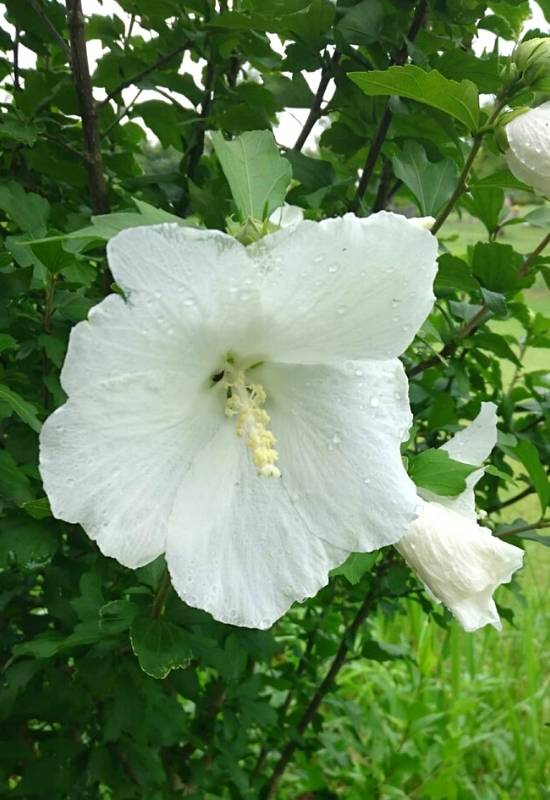
Snow white ‘Diana’ is a unique rose of Sharon cultivar! Let me be clear: it is all white!Pure white are the petals, no central purple at all. And white is the pistil with stamens complex too!
I would have named it ‘Snow White’ in fact. The flowers are actually large as well, reaching 5 to even 6 inches across (12 to 15 cm)! I am sure you can appreciate the amazing wonder this hibiscus is…
If you want candid presence in your garden, Hibiscus syriacus ‘Diana’ is ideal, as it is excellent for white gardens, of course, where no other rose of Sharon would fit.
10: Rose of Sharon ‘Minerva’ (Hibiscus syriacus ‘Minerva’)
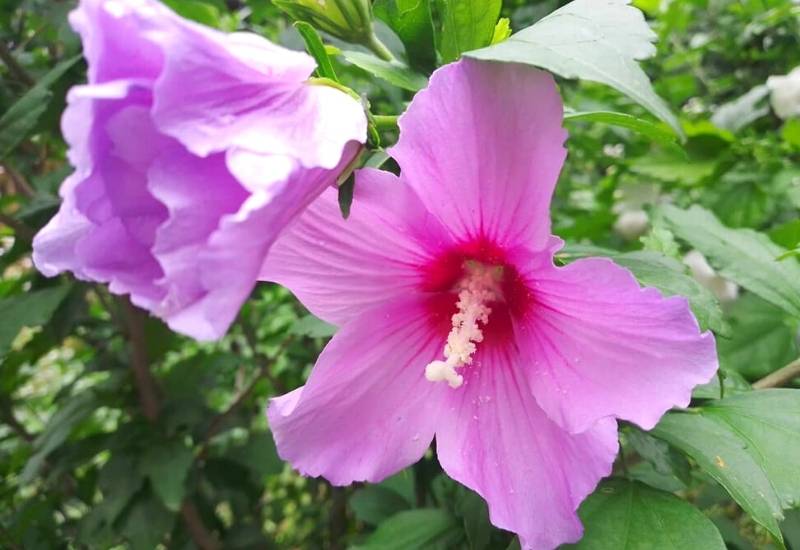
‘Minerva’ is a classic in the rose of Sharon world… The flowers are lavender magenta in shade, bright and showy, and the central “eye” is bright red, which adds an accent to the overall effect. The yellow stamens on the pale pistil finally add a touch of light to the ensemble.
The plant is fairly short, while the flower heads are about 3 inches across (8 cm) and they look lovely in the Sun!
Hibiscus syriacus ‘Minerva’ is a showy variety for a brightly colored garden. And it may well be your garden if you like it.
11: Rose of Sharon ‘Aphrodite’ (Hibiscus syriacus ‘Aphrodite’)
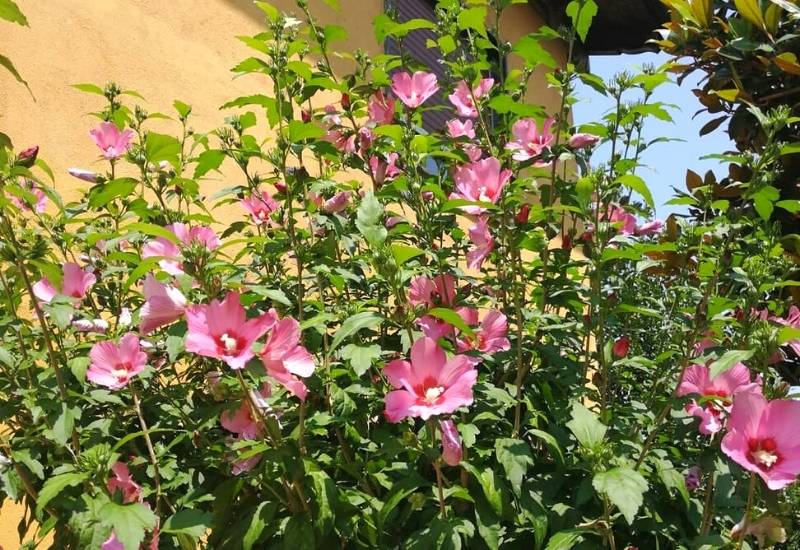
Rose of Sharon ‘Aphrodite’ is the romantic version of ‘Minerva’. The showy flowers have a rich link shade with a dark red central patch. This makes it very balanced yet vibrant as a flower.
The whole is then lit up even further by the bright yellow stamens! The flower heads are fairly large, about 4 inches (10 cm) in diameter, but the plant is fairly small.
Hibiscus syriacus ‘Aphrodite’ is ideal if you want a bright but romantic show even if you have a small space: it tends to stay small, in fact, and it’s ideal for containers!
12: Rose of Sharon ‘Lil Kim’ (Hibiscus syriacus ‘Lil Kim’)
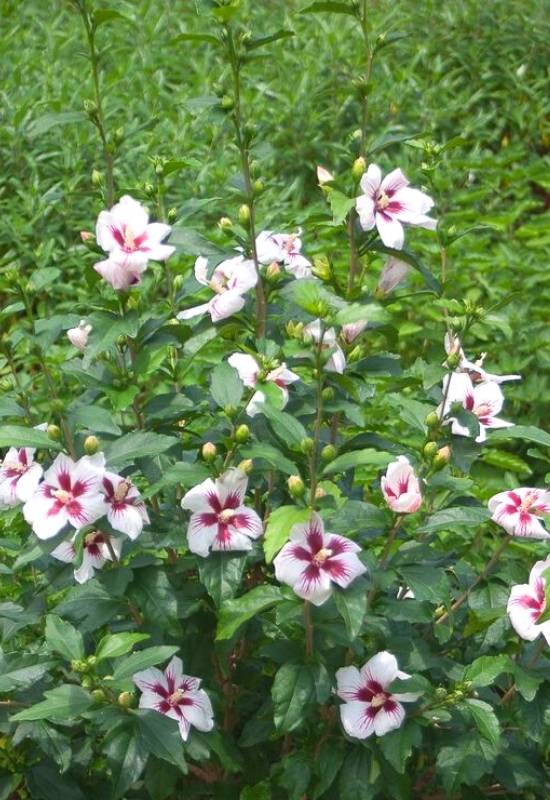
‘Lil Kim’ is a dwarf variety of rose of Sharon, and the name gives it away. The color pattern of the flowers is exactly the same of the classical ‘Purple Heart’, only the purple patches extend rays almost to the end of the white petals.
It has an upright habit but it is a very small hibiscus indeed: it never passes the 4 feet tall (1.4 meters).
Choose Hibiscus syriacus ‘Lil Kim’ if you need a classical looking white and purple cultivar for medium height borders. And if you only have a small space, it is a perfect container variety to grow on terraces.
13: Rose of Sharon ‘Blue Chiffon’ (Hibiscus syriacus ‘Blue Chiffon’)
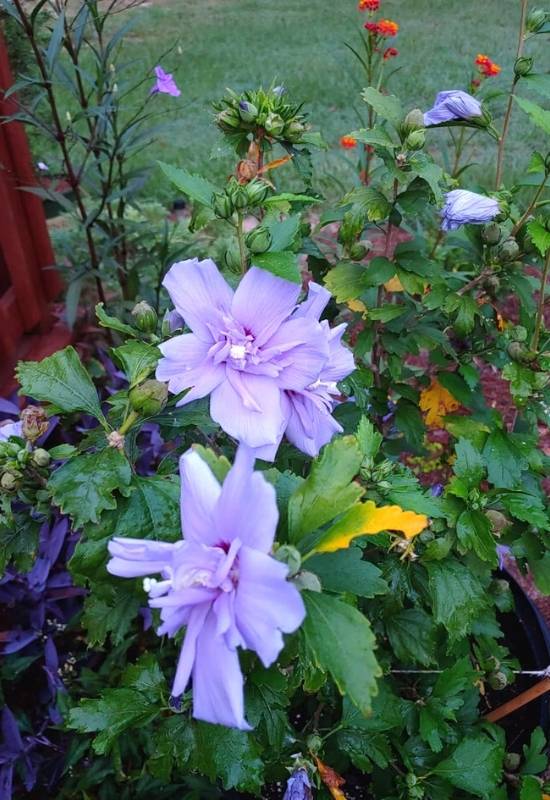
‘Blue Chiffon’ is a striking semi double variety of rose of Sharon! It has pastel blue petals; the outer ones are broad and round, while the inner ones are smaller, thinner and elongated, like a chiffon indeed.
The larger petals retain a star shaped purple pattern you can still see behind the inner ones. The stamen and pistils and white, which sets off the sky color very well.
This rose of Sharon is a winner of the prestigious Award of Garden Merit by the Royal Horticultural Society.
Hibiscus syriacus ‘Blue Chiffon’ is a show stopper; if you choose it, make sure you put it where everybody can see it.
14: Rose of Sharon ‘Orchid Satin’ (Hibiscus syriacus ‘Orchid Satin’)
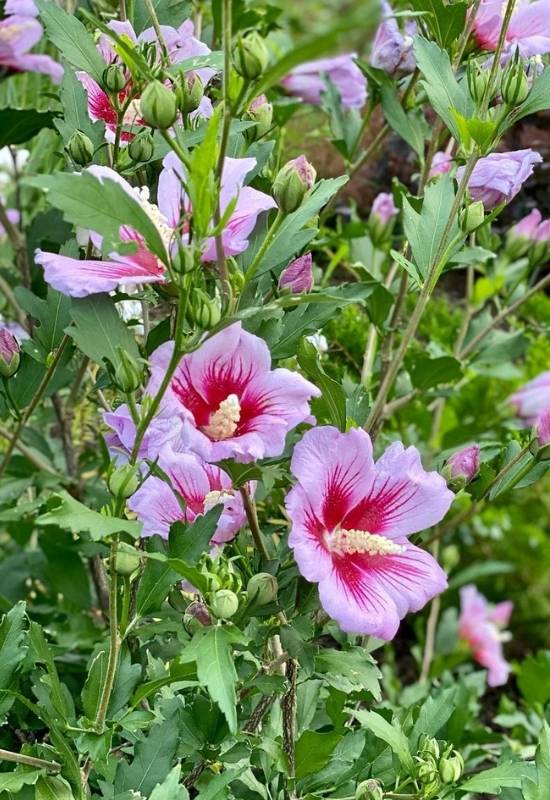
‘Orchid Satin’ is a recent rose of Sharon cultivar with a few important claims… It is a very showy variety with large heads that reach 5 inches across (12 cm). These have broad, rounded petals with a central red star,
while the petals are of a faint but beautiful lavender pink shade you can confuse for white at a distance. It is a very sought after variety and it can bloom for the whole of summer too!
I would suggest Hibiscus syriacus ‘Orchid Satin’ if you are looking for an exotic looking protagonist to grow in your garden or on your terrace.
A Beautiful Range of Rose of Sharon Varieties
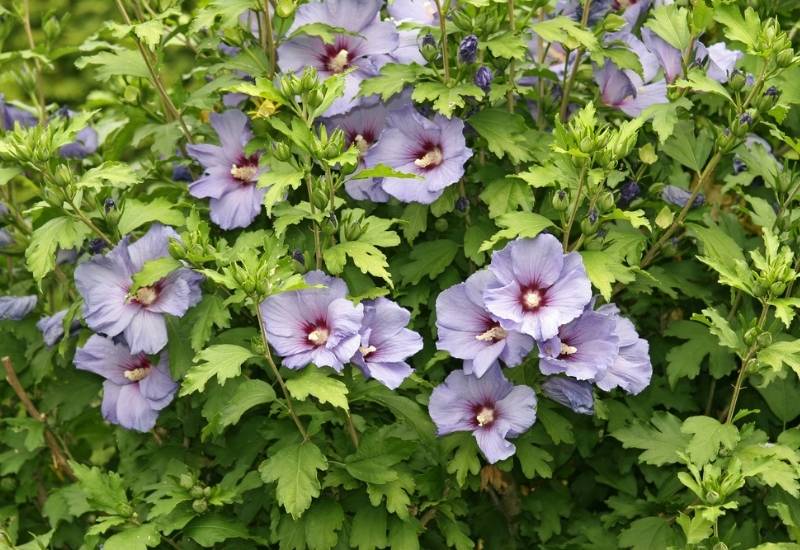
From the original Hibiscus syriacus in China, gardeners have had a lot of fun developing new cultivars and varieties!
White, purple, pink, blue varieties in many combinations…
Single, double and semi double flowers and even small and dwarf varieties.
They are all easy to grow; you can keep any of these varieties as a bush or make it into a tree.
But each cultivar you have seen has its special qualities, personality and place: just make sure you choose the best one for you!

Written By
Amber Noyes
Amber Noyes was born and raised in a suburban California town, San Mateo. She holds a master’s degree in horticulture from the University of California as well as a BS in Biology from the University of San Francisco. With experience working on an organic farm, water conservation research, farmers’ markets, and plant nursery, she understands what makes plants thrive and how we can better understand the connection between microclimate and plant health. When she’s not on the land, Amber loves informing people of new ideas/things related to gardening, especially organic gardening, houseplants, and growing plants in a small space.

very nice summary and well-illustrated. one typo…. the word link should have been pink in the Aphrodite description.
I solved an issue with weediness of single varieties Rose of Sharon being prolific seeders and seedlings appearing everywhere including under the plant and in the lawn. Late in flowering season when the flowering is just starting to wind down, prune all flowering stems back far enough to remove ALL developing seed pods. Hold each stem by the tip, cut with pruners and drop directly into garbage. Do this early, well before any pods start to change colour from green to yellowish green. Too early is better than too late. Far better to lose a few blooms than risk having to pull out these pesky taprooted unwelcome guests. Now you do not have to say no to Rose of Sharon any more! Be sure to include Bluebird – it is a standout! Though I am envious of tropical varieties of hibiscus for their extensive colour pallet, temperate gardeners have bluebird! And our huge herbaceous mallows extend our colour range to include knockout reds! And if we have hibisus envy, we can always grow one or two tropical hibiscus as summer annuals in pots for our staycation garden!
Mike,
Do you have any seeds that you can share.
I in Mississauga.
Malcolm
I planted three rose of sharons. They seemed very healthy. I live in Zone 5. We got a late frost one night 29 degrees. all the leaves died. Is this normal? Will the plants survive? I was told to plant them in the spring when the temp. was cool.
Oh no, that late frost must have been quite a shock to your newly planted rose of Sharon! It’s unfortunate, but frost damage can happen, especially when unexpected temperature drops occur.
When it comes to late frosts, tender new leaves and shoots are particularly vulnerable. It’s not uncommon for the leaves of plants to die off after exposure to such low temperatures. While it’s disheartening to see the leaves wilt and perish, it doesn’t necessarily mean that your plants won’t survive.
Rose of Sharon plants are generally hardy and resilient. Even if the leaves have died, the plants may still bounce back. Keep an eye on the stems and branches for any signs of life. If they remain green and pliable, it’s a good indication that the plants are alive and have a chance of recovering.
Here’s what you can do to help your rose of Sharon plants recover:
Be patient: Give the plants some time to recover from the frost damage. Sometimes, new leaves may sprout from the existing branches or from the base of the plants.
Remove dead foliage: If the leaves have turned brown or black, you can gently prune or remove them. This will not only improve the appearance of the plants but also prevent any potential disease or pest issues.
Provide care: Ensure that your rose of Sharon plants receive proper care. Water them regularly, but avoid overwatering. Apply a layer of mulch around the base of the plants to retain moisture and regulate soil temperature. Additionally, consider fertilizing them with a balanced fertilizer to support their recovery.
Monitor growth: Keep a close eye on the plants as the growing season progresses. Look for any signs of new growth, such as sprouting leaves or buds. These are positive indicators that your plants are regenerating.
Remember, gardening can sometimes be unpredictable, especially when it comes to weather events like late frosts. While there’s no guarantee, there’s still hope that your rose of Sharon plants will bounce back and thrive. Stay optimistic and provide them with the care they need, and you may be pleasantly surprised by their resilience.
Yes share some seeds with me too Mike! I’m in Port St Joe, Florida.
Amy thank you for this article and the lovely pictures!!!